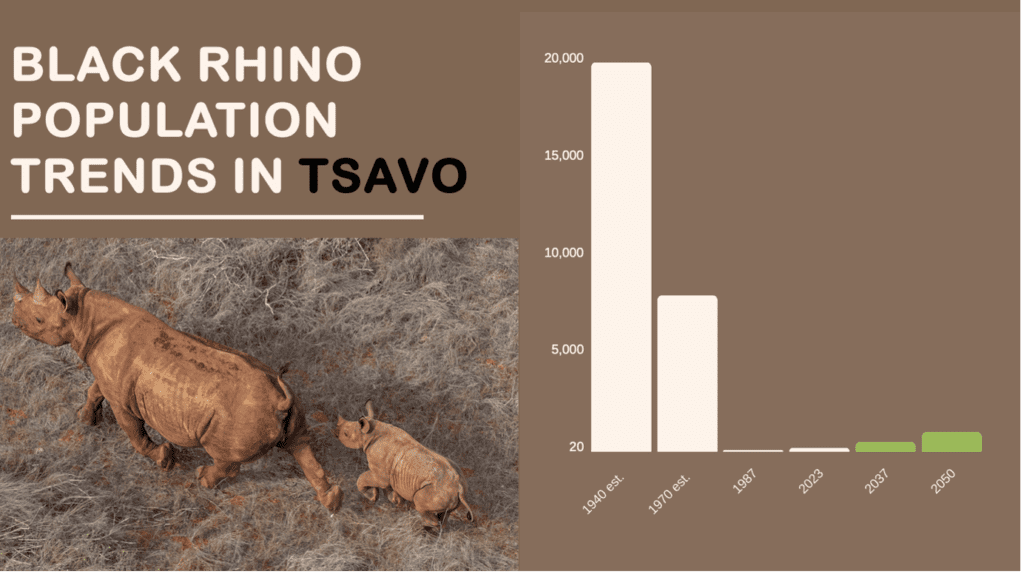Flying over the vast savannahs and rugged hills of Tsavo West National Park, pilot Nicholas Haller has a front-row seat to one of Kenya’s most ambitious and critical conservation programmes: the protection of the eastern black rhino. As part of Tsavo Trust’s aerial surveillance team, Nick is tasked with monitoring rhino movements, identifying threats, and supporting ground operations in a region that holds one of the largest remaining free-ranging black rhino populations in Africa.
His work, along with the broader efforts of Tsavo Trust, Kenya Wildlife Service (KWS), and other conservation partners, is helping to secure the future of this critically endangered species. In 2024 alone, Tsavo Trust’s aircraft flew more than 351 hours and covered over 40,500 kilometres on rhino patrols—a testament to the scale and dedication behind the mission.
Not just a job: a shared mission
Tsavo Trust has long been recognised for its role in protecting Tsavo’s wildlife—particularly its iconic Super Tusker elephants and endangered black rhinos. But it’s not just about patrol hours or aircraft maintenance; it’s about the people behind the mission. Whether they’re pilots, rangers, scientists or community officers, each member of the team shares a deep commitment to protecting Tsavo’s extraordinary biodiversity.
For Nicholas Haller, flying these missions is a calling. While aerial patrols are guided by strategic goals and telemetry data, they’re also driven by passion—the passion to ensure that the next generation of Kenyans and visitors alike can witness a wild black rhino roaming Tsavo.

A typical day in the skies
A day of aerial patrol begins early, often before sunrise, with pre-flight checks and a weather briefing. Once airborne, Haller heads towards known rhino territories, mostly within the 3,000 km² Intensive Protection Zone (IPZ). Flying low and slow in a Super Cub aircraft or the new Robinson R44 helicopter, he scans the terrain for movement, fresh tracks, or signs of unusual activity.
Sometimes, telemetry signals from VHF transmitters help locate individual rhinos, while other times it’s about reading subtle cues—changes in vegetation, disturbed soil, or the flash of grey hide through the bushes. Sightings are logged, GPS coordinates are recorded, and any concerning signs—like potential poaching camps or habitat encroachment—are relayed immediately to KWS and Tsavo Trust ground teams.

Aerial eyes and rapid response
Aerial surveillance adds a crucial layer to rhino protection. From the air, vast areas can be covered quickly—much faster than any ground team could manage. This speed allows pilots to identify and respond to threats in real time. Whether it’s illegal activity, bushfires, or an injured animal, Haller’s role is to provide eyes in the sky and coordinate with those on the ground.
If a threat is spotted, the aircraft may circle while ground teams move in. In the case of an injured rhino or a calf separated from its mother, aerial units can guide veterinary teams directly to the location. In poaching hotspots, the ability to hover in a helicopter or land nearby provides an invaluable tactical advantage.

The power of partnership
One of Tsavo Trust’s greatest strengths is its collaborative model. Working alongside KWS and the Wildlife Research and Training Institute (WRTI), Tsavo Trust brings extensive experience in aerial and ground-based conservation. Its 12 Tembo anti-poaching teams, infrastructure support, and community engagement initiatives create a comprehensive approach to wildlife protection.
In the Tsavo West IPZ alone, Tsavo Trust has contributed:
- Thousands of hours of aerial patrols covering more than 158,000 kilometres in the past five years
- Deployment of three anti-poaching teams in key rhino zones, resulting in 779 arrests
- Construction of ranger bases, ops posts, and water infrastructure including eight sand dams
- Provision of telemetry equipment, camera traps, and census support tools
- Rhino transmitter and ear-notching exercises for improved individual tracking
- Strong community partnerships through Kamungi Conservancy
This multi-pronged support helps to bridge the gap between current capacity and the long-term goal of making Tsavo West a global stronghold for black rhinos.
The road ahead
Kenya’s national rhino conservation strategy aims to increase the country’s population of eastern black rhinos to 2,000 by 2037. With just under 1,000 currently, and many small sanctuaries nearing ecological carrying capacity, large, secure landscapes like Tsavo are critical to achieving this target.
The Tsavo West IPZ has the potential to support at least 500 black rhinos—nearly 10% of the world’s total population. With ongoing aerial patrols, continued funding, and coordinated strategy, Tsavo Trust and its partners are laying the foundation for a future where rhinos can roam freely, securely, and sustainably.

How you can help
Tsavo Trust’s aerial patrols play a vital role in safeguarding Kenya’s rhinos—but they rely on donor support to keep flying. Every hour in the sky is another opportunity to protect a rhino, detect a threat, or save a life.
In the words of those who patrol the skies every day: every flight matters, and every rhino counts.

